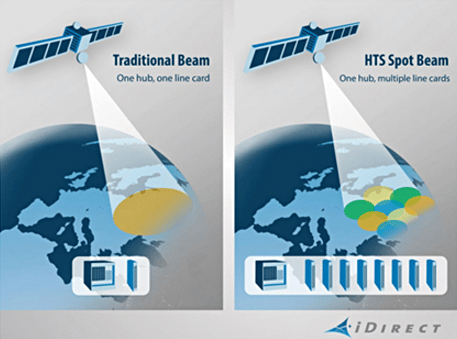 The term High Throughput Satellite (HTS) has become synonymous with the satellite industry’s promising future. And when we think of HTS, we often focus narrowly on throughput. Yet, the future of how satellite connectivity hinges on much more than how fast can we speed up an end-user network.
The term High Throughput Satellite (HTS) has become synonymous with the satellite industry’s promising future. And when we think of HTS, we often focus narrowly on throughput. Yet, the future of how satellite connectivity hinges on much more than how fast can we speed up an end-user network.
That’s because HTS is more than a term. It’s an important step forward in a broader technology evolution that encompasses every aspect of satellite networking. It means redefining how we operate our industry and manage our respective businesses.
Here are some critical points to consider for the future of our industry – four areas where we need to take not just one step forward, but a giant leap ahead.
#1 – Create higher capacity efficiencies and enable intelligent payloads.
HTS, along with DVB-S2X, transforms the performance and efficiency of satellite capacity. DVB-S2X delivers higher efficiencies and saturates larger transponders (with time slicing), helping to bring costs per bits down.
When implemented to its fullest, satellite operators can design next-generation architectures with features like beam hopping to adjust their payloads based on real-time demand on the ground. Intelligent payloads require the integration of ground and space infrastructure to measure and respond to demand. So terminals designed for HTS must support the full DVB-S2X standard – that’s the key to much more significant efficiency gains in the years ahead.
#2 – Develop faster terminals by designing smarter terminals.
Today, there is a new model for engineering satellite remotes. Traditionally, a satellite remote’s features were largely encoded in hardware or were over-engineered to capabilities you didn’t use most of the time. As such, they carry a high cost to operate and could become a network’s single greatest bottleneck.
Today, you need a remote solution that’s engineered with a high degree of flexibility to adapt to changing requirements while only paying for the capabilities that you really need at any given time. Through software licensing, these remotes can be continually upgraded over the air to increase network capabilities and throughput levels, while dramatically extending the deployment life of the remote.
#3 – Make scale more affordable by making it more virtual.
With greater demand for higher throughputs and more satellite bandwidth comes the need to deploy and manage large-scale networks. Satellite operators and service providers need to change the cost model for ground infrastructure deployment, keeping up with demand without dramatically increasing capital and operating expenses. The key is adopting virtualization and cloud computing practices that enable service providers to build out massive networks with greater speed and reduced operational costs.
#4 – Match mainstream prices with mainstream network integration.
The ultimate promise of HTS is to position satellite as a viable part of the end-to-end network. The first step is aligning satellite with terrestrial and mobile network service fees. But the key to full mainstream adoption is for satellite networks to be defined by modern telecom standards such as 4G/5G, L2oS, and EPC.
And for true integration, a satellite platform’s management system must sync with a carrier’s existing Operational Support Systems (OSS) and Business Support Systems (BSS). Through full OSS/BSS integration, with the help of APIs, it’s easier to scale operations. The ultimate goal is a fully automated, programmable and orchestrated network that delivers service on demand to meet any requirement rapidly and cost-effectively.
Take HTS Further
iDirect’s technology strategy enables our customers to deliver the highest speed and the greatest efficiency over HTS, scale their networks cost-effectively to manage growth, seamlessly integrate with terrestrial and mobile networks, and be ready to operate over future satellite architectures. Learn more about it at IntelligentPathForward.com.
Greg Quiggle, Vice President, Emerging Products, VT iDirect, will be speaking on the GVF HTS Roundtable on May 16 in Washington, D.C. We hope to see you at the event for some lively discussion about the opportunities of HTS.